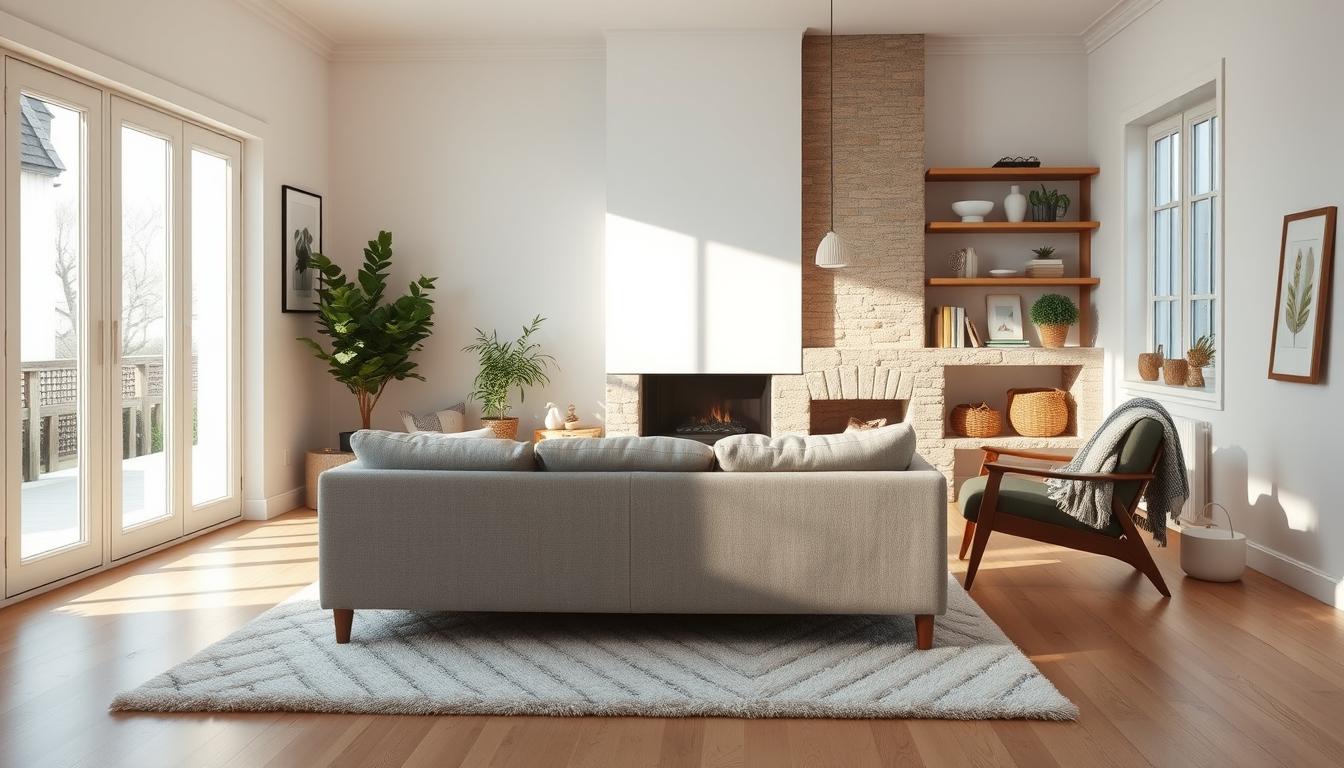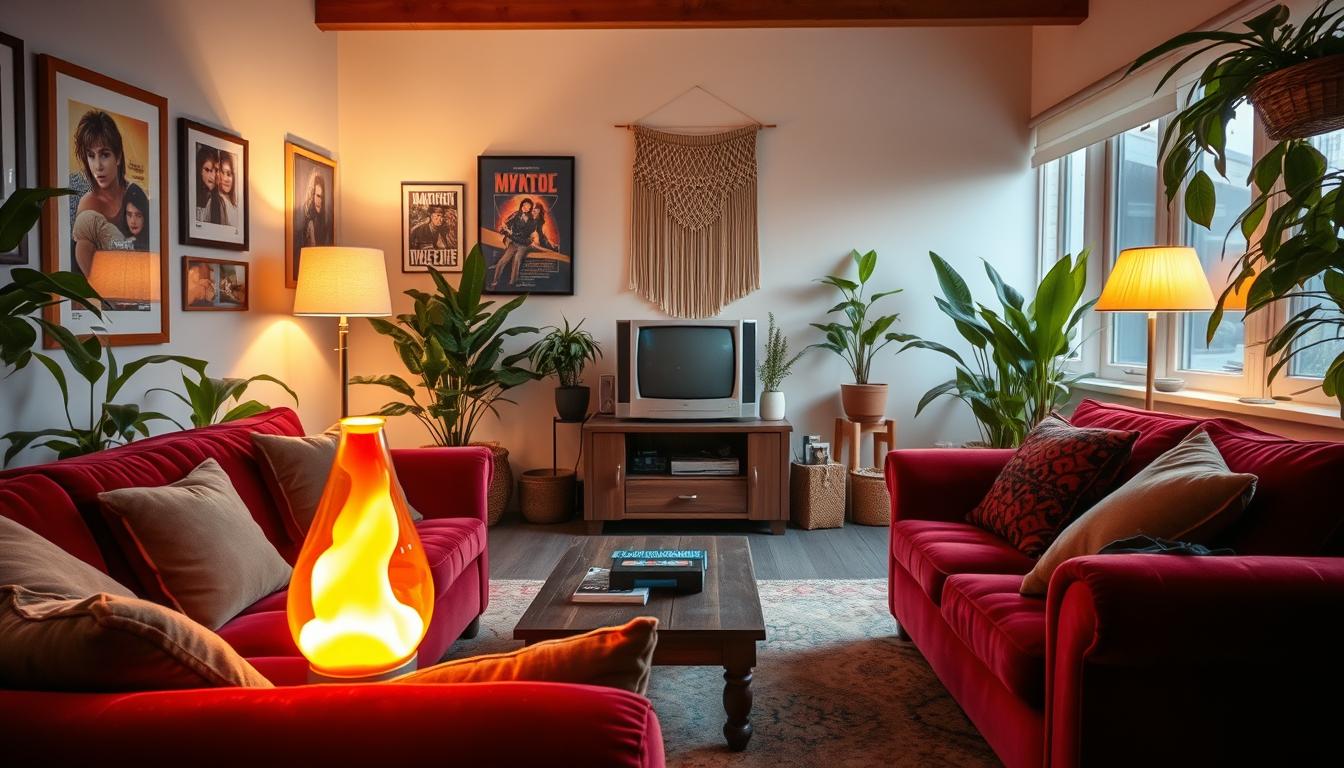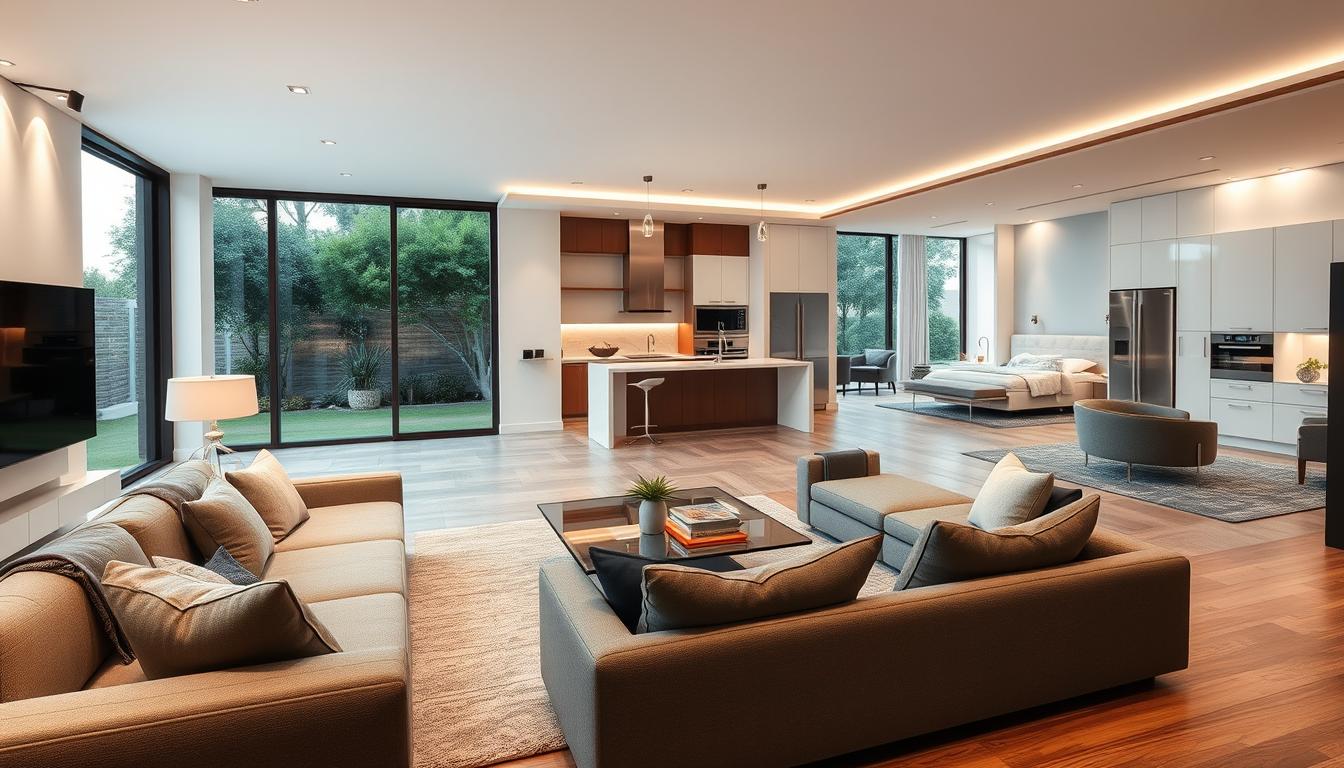Did you know Nordic interior style is loved all over the world? It’s known for being simple, useful, and warm. This design is now a big trend in decorating homes.
In this guide, we’ll dive into what makes Scandinavian design special. We’ll look at its history and main features. Plus, we’ll share tips on how to bring this style into your home decor. You can go all in with Scandinavian or just add some Nordic flair.
Key Takeaways
- Understanding the core principles of Scandinavian design
- Learning how to incorporate Nordic elements into your decor
- Discovering the history and evolution of Scandinavian design
- Exploring the key characteristics of Nordic interior style
- Practical tips for adopting a Scandinavian aesthetic in your home
What is Scandinavian Home Interior Design?
The Scandinavian interior design movement started in the early 20th century. It focused on minimalism and natural materials. This design was a response to the cluttered interiors of the time, aiming for a more serene and functional space.
The Origins of Scandinavian Design
Scandinavian design began in Norway, Sweden, and Denmark in the early 20th century. It was shaped by the need for simplicity and functionality. The movement became popular in the 1950s, known for minimalist Scandinavian design.
Designers like Arne Jacobsen and Hans Wegner led this movement. They created furniture that was both beautiful and practical.
Key Characteristics and Principles
At its heart, Scandinavian decor is guided by a few key principles:
- Simplicity and minimalism
- Emphasis on natural materials and textures
- Functionality and practicality
- Use of light colors and natural light
These principles help create a cozy and inviting space. Natural materials and light colors add warmth and comfort. The focus on functionality keeps the space practical and uncluttered.
Understanding these core principles helps us see the beauty of Scandinavian design. It shows us how to make our homes more serene and functional.
Essential Elements of Scandinavian Design
Scandinavian design focuses on simplicity, functionality, and nature. It combines these elements to create a welcoming space. This philosophy is key to Scandinavian design.
Color Palette
The Scandinavian color palette uses muted tones like white, gray, and beige. These colors create a calm background. They let natural textures and materials shine. Adding subtle colors through textiles or art adds depth.
Furniture Selection
Furniture in Scandinavian homes is minimalist and functional. It has clean lines and little decoration. This design makes spaces feel open and flowing.
- Simple, clean lines
- Minimal ornamentation
- Functionality
- Use of natural materials
Textiles and Materials
Textiles and materials are vital in Scandinavian design. They add warmth and texture. Wood, wool, and linen are preferred for their beauty and durability. Mixing textures brings depth and interest to a room.
The Importance of Natural Light
Maximizing natural light is key in modern Scandinavian interiors. It makes spaces feel open and airy.
Natural light is vital in Scandinavian home design, more so in long, dark winters. It brightens the space and improves the mood, making rooms feel bigger and more inviting.
Maximizing Light in Your Space
To get more natural light, think about your furniture layout. Move furniture away from windows and use mirrors to bounce light deeper into the room.
- Use sheer curtains or blinds to filter the light while keeping the view.
- Select furniture with light-colored finishes to reflect light.
- Minimize clutter to maintain a sense of openness.
Interior design experts say, “The essence of Scandinavian design is creating a cozy atmosphere, or hygge. This is greatly influenced by natural light.”
“Light is not just a practical necessity; it’s an emotional and psychological one as well.” –
Window Treatments for Scandinavian Style
Window treatments in Scandinavian homes are simple and functional. They help bring in more natural light. Sheer fabrics, linen curtains, and wooden blinds are favorites.
| Window Treatment | Description | Benefits |
|---|---|---|
| Sheer Fabrics | Lightweight, translucent materials | Allows natural light to filter through while maintaining privacy |
| Linen Curtains | Natural, textured fabric | Adds warmth and texture to the room |
| Wooden Blinds | Simple, natural wood construction | Provides control over light levels and adds a natural element |
By using these strategies and choosing the right window treatments, you can brighten your Scandinavian-inspired home. This makes it feel more welcoming and inviting.
Minimalism: The Heart of Scandinavian Design
Scandinavian design is all about minimalism. It creates calm and functional spaces. This philosophy values simplicity, function, and nature.
To follow minimalist Scandinavian design, start with decluttering. A clean space looks better and feels calmer. We’ll show you how to declutter and keep your home simple.
Decluttering Your Space
Decluttering is key to minimalist Scandinavian interiors. It’s not just about removing stuff. It’s about making your space useful and lovely. Here are some tips to begin:
- Begin with one room to avoid feeling too much.
- Sort items into keep, donate, sell, or discard piles.
- Think about each item’s purpose. If it doesn’t serve a need, it’s okay to get rid of it.
Decluttering simplifies your space and helps you focus on what matters.
Choosing Functional Furniture
After decluttering, pick furniture that fits minimalist Scandinavian design. Look for pieces that are both useful and nice to look at.
| Furniture Piece | Characteristics | Benefits |
|---|---|---|
| Sofa | Simple design, neutral color, durable fabric | Comfortable seating, easy to maintain |
| Coffee Table | Minimalist legs, compact size, storage | Functional surface, doesn’t clutter the space |
| Bookshelf | Simple lines, minimal ornamentation, versatile | Organizes books and decor, adds to the minimalist aesthetic |
Choose furniture that fits your room well and does more than one thing. This follows the minimalist idea and makes your space more useful.
By embracing minimalism and picking the right furniture, you can make a Scandinavian-inspired home. This design makes your space simple, beautiful, and peaceful.
Incorporating Nature into Scandinavian Interiors
In Scandinavian design, nature is more than a trend; it’s a lifestyle. This philosophy shows in how natural elements are used in homes. It makes spaces both beautiful and in harmony with nature.
Biophilic Design Principles
Biophilic design connects us back to nature. It uses natural light, air, and materials to boost our well-being and work. In Scandinavian homes, this is done with wood, stone, and plants.
Key biophilic design elements include lots of natural light, natural materials, and plants. These not only make a space look good but also make it healthier.
Indoor Plants That Enhance Your Space
Indoor plants bring nature into your Scandinavian home. They clean the air, look good, and make you feel calm. Succulents and snake plants are great because they’re easy to care for.
- Snake Plant: Known for its air-purifying properties and low maintenance.
- Succulents: Perfect for adding a touch of greenery with minimal care.
- Pothos: Easy to care for and great for hanging baskets.
By using natural elements and biophilic design, you can make your Scandinavian interior feel like the outdoors. It makes your living space more beautiful and connected to nature.
The Role of Geometry in Design
In Scandinavian design, geometry is key to harmony and balance. Geometric shapes and clean lines make up the minimalist look of Scandinavian interiors.
Shapes and Lines in Scandinavian Aesthetics
Scandinavian design often uses simple shapes like circles, rectangles, and triangles. These shapes are found in furniture and decor, creating a unified look. Clean lines add to the simplicity and elegance of Scandinavian design.
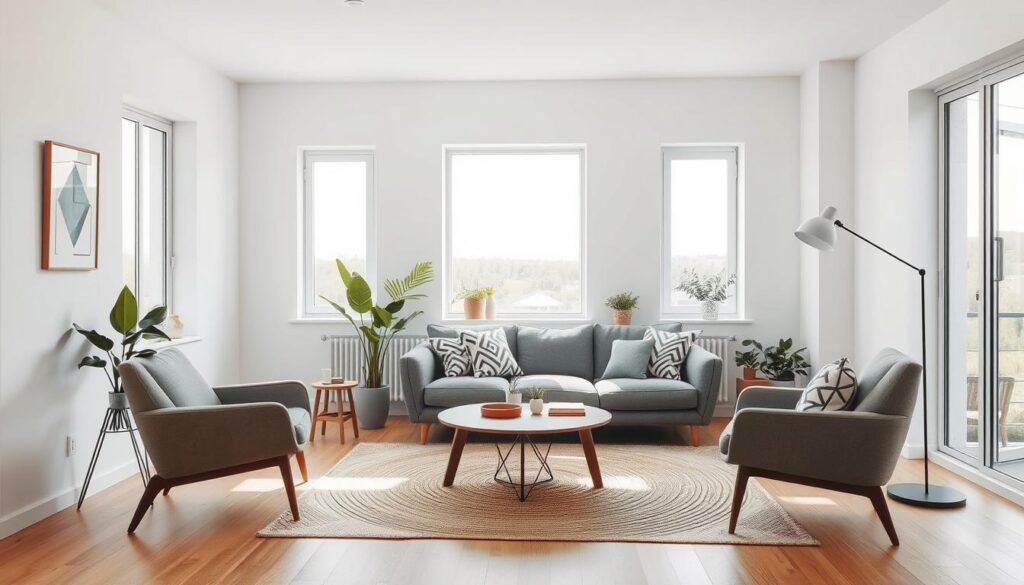
Balance and Proportion in Furniture Arrangement
Balance and proportion are crucial in Scandinavian furniture arrangement. It’s important to think about the size and scale of furniture in relation to the room. Proportionate sizing makes the space feel harmonious and uncluttered.
| Geometric Element | Design Impact | Example |
|---|---|---|
| Clean Lines | Contributes to a minimalist aesthetic | Sleek sofa designs |
| Simple Shapes | Creates a sense of harmony | Circular coffee tables |
| Proportionate Sizing | Ensures a balanced space | Balancing large sofas with smaller armchairs |
By focusing on geometric elements like shapes, lines, and proportion, you can make your home Scandinavian-inspired. This design approach makes your space modern and cozy. It also improves the aesthetic appeal and contributes to well-being.
Creating a Cozy Atmosphere: Hygge
Hygge can turn your home into a cozy haven. It’s a Danish concept that means feeling warm and content. It’s key to Scandinavian home design.
Understanding Hygge
Hygge is more than design; it’s a way of life. It’s about feeling at home and relaxed. To get hygge, use soft lights, comfy textiles, and warm colors.
Soft lighting is key for hygge. Table lamps, floor lamps, or string lights add warmth. Candles also bring warmth and coziness.
Tips for Achieving a Cozy Space
To add hygge to your home, start by decluttering. Here are some tips:
- Use plush textiles like throw blankets, rugs, and pillows in warm colors.
- Add natural materials like wood and wool to your decor.
- Choose soft, warm lighting, like candles or fairy lights.
- Make cozy nooks with comfy seating and good reading lights.
- Use earthy tones and rich colors in your furniture and decor.
By following these tips, you can make your home cozy and inviting. This not only looks good but also makes you feel better.
Adding hygge to your home is more than following trends. It’s about making a space that feels welcoming. By focusing on coziness, you can make your home a place of relaxation.
Sustainable Practices in Scandinavian Design
Sustainability is key in Scandinavian design. It affects everything from the materials used to how much energy is saved. This focus on the environment is not just a passing trend. It’s a fundamental principle that shapes Scandinavian interiors.
Eco-Friendly Choices
Choosing eco-friendly materials is a big part of Scandinavian design. Designers and homeowners pick materials that look good and are kind to the planet. For example, reclaimed wood is often used for furniture. It’s good for the environment and adds character to the pieces.
Textiles also play a role in sustainability. Fabrics like wool, cotton, and linen are chosen for their durability and ability to break down naturally. Many Scandinavian brands are now using recycled materials in their products. This helps cut down on waste.
Energy Efficiency in Scandinavian Homes
Energy efficiency is crucial in Scandinavian design. Homes are built to let in lots of natural light. This cuts down on the need for artificial lighting and makes the home feel cozy. Features like large windows, skylights, and mirrors help bring in more light.
Scandinavian homes also use energy-saving heating systems. For instance, many use district heating systems. These systems heat multiple buildings from one source, saving energy and reducing emissions.
| Eco-Friendly Material | Benefits | Examples |
|---|---|---|
| Reclaimed Wood | Reduces need for new lumber, unique aesthetic | Furniture, flooring |
| Natural Fibers | Durable, biodegradable | Upholstery, bedding |
| Recycled Materials | Reduces waste, conserves resources | Insulation, decorative elements |
Scandinavian design is all about being green. It makes homes not just beautiful but also functional. As we learn more about Nordic interior style, it’s clear that being eco-friendly is what makes it stand out.
Choosing the Right Lighting Fixtures
In Scandinavian design, lighting is more than just a need; it’s an art that changes spaces. The right lights can make a room feel cozy and welcoming.
Scandinavian homes mix function with beauty in their lighting. They aim to create a warm, inviting space that matches the Scandinavian color palette and modern interiors.
Types of Lighting in Scandinavian Homes
Scandinavian homes use various lights for a layered look. This includes:
- Table lamps for task lighting and adding warmth.
- Floor lamps for ambient lighting and coziness.
- Pendant lights for modern elegance.
Each light has its role, adding to the space’s beauty. Mixing them creates a hygge feel, truly Scandinavian.
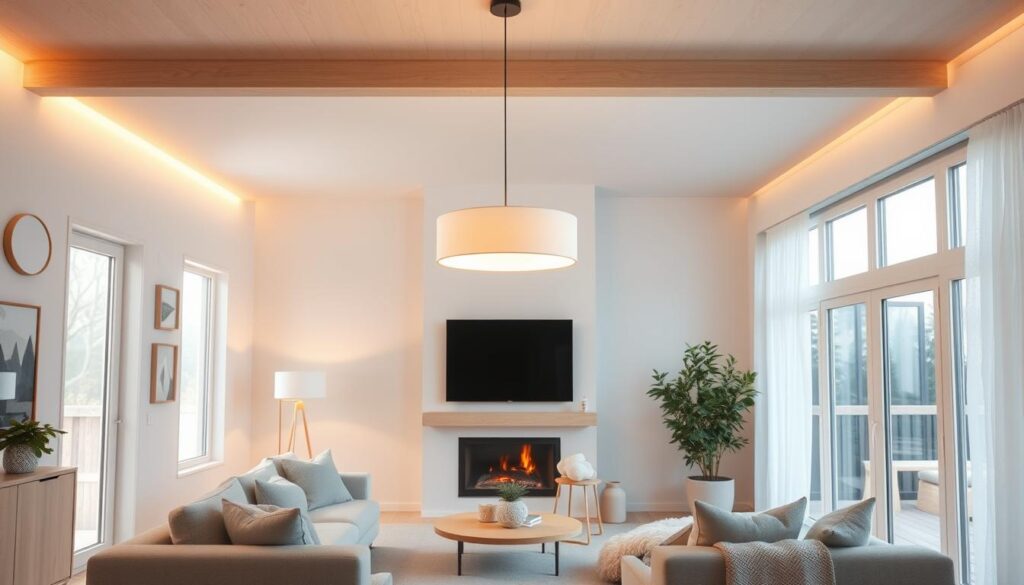
Popular Scandinavian Lighting Brands
Many brands are famous for Scandinavian lighting. Some top ones are:
- Poul Henningsen, known for his PH lamp series.
- Louis Poulsen, working with top designers for innovative lights.
- Muuto, offering modern, minimalist lights.
These brands follow Scandinavian design’s key principles. They focus on simplicity, function, and natural light.
Choosing lights from these brands can improve your home’s feel. It makes your space reflect the beauty of modern Scandinavian interiors.
Decorating with Art and Accessories
Art and accessories let you add your personal touch to a Scandinavian-style home. This style is known for being simple yet open to personal expression. It’s all about choosing the right decorative pieces.
Selecting Artwork that Complements Your Space
Choosing artwork for your Scandinavian home is key. Pick pieces that fit well without making the space feel crowded. Choose art that speaks to you, like paintings, prints, or photos. Make sure it matches your decor’s color and style.
Think about the frame’s style and color too. A simple frame can make the artwork stand out without overwhelming it. Here’s a quick guide to frame styles:
| Frame Style | Description | Best For |
|---|---|---|
| Minimalist | Simple, thin frames | Modern art, black and white photos |
| Wooden | Natural wood tones | Earth-toned artwork, nature photography |
| Ornate | Detailed, decorative frames | Traditional or vintage art pieces |
Tips for Accessorizing with Care
Accessorizing is an art in itself, even in Scandinavian design. The goal is to add personality without cluttering. Start with a few, meaningful pieces that show your style or interests.
Remember the rule of three: group items in threes for a nice look. This could be three vases or three decorative objects. Here are some tips:
- Choose items that have a personal significance or tell a story.
- Mix textures and materials to add depth to your space.
- Keep surfaces clear to maintain a sense of openness.
By carefully choosing art and accessories, you can make your Scandinavian home truly yours. It becomes unique and welcoming.
Open Concept Living in Scandinavian Style
The idea of open concept living fits well with Scandinavian design. It makes spaces feel connected and open. This design also helps people spend more time together.
Benefits of Open Spaces
Open concept living has many advantages:
- It makes spaces feel bigger and freer.
- It boosts social interaction.
- It lets in more natural light.
- It makes living spaces more flexible.
Removing walls makes living more fluid. It’s great for families and those who love to connect.
Tips for Achieving a Flowing Layout
To get a flowing layout, try these tips:
- Minimize Clutter: Keep your space tidy to keep it feeling open.
- Use Multi-Functional Furniture: Choose furniture that does more than one thing, like storage ottomans.
- Select a Cohesive Color Scheme: Use the same colors to make your space feel connected.
- Incorporate Natural Elements: Add plants, wood, and stone to warm up your space.
Embracing open concept living and using these tips can make your home feel bigger and more welcoming. It’s a key part of Scandinavian design.
Personalizing Your Scandinavian Interior
Scandinavian design is more than just minimalism and function. It’s about making a space feel personal and welcoming. To make your Scandinavian home unique, mix modern and vintage pieces. Choose Scandinavian furniture that shows off your style.
Merging Modern and Vintage Pieces
Combining modern Scandinavian interiors with vintage items adds depth and character. Try pairing a sleek, low-profile sofa from IKEA with a vintage armchair or an antique coffee table. This mix of old and new creates a visually interesting and layered look.
Adding Personal Touches
Adding personal touches is key to making your Scandinavian space feel truly yours. Hang family photos, display heirlooms, or showcase artwork that speaks to you. These thoughtful additions create a warm and inviting atmosphere while staying true to Scandinavian design principles.

